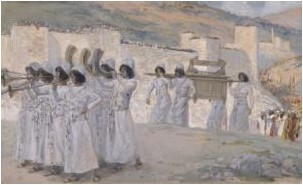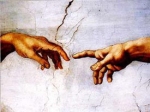Verse: Mark 7:8-9 You leave the commandment of God and hold to the tradition of men."
And he said to them, "You have a fine way of rejecting the commandment of God in order to establish
your tradition! ESV
In today’s lesson we have an example of how tradition introduced, by what was most likely well-
meaning Rabbis, a distortion of the meaning and focus of the Feast of Trumpets.
The beginning of the Babylonian New Year coincided with the appointed time of YHWH called “Yom
Teruah”, the first day of the seventh month. The Jews “exported” some of the Babylonian traditions
when they restored Temple worship and returned to the land of Israel and Jerusalem. This mixture with
the Babylonian New Year developed in complexity over the generations until the appointed time of Yom
Teruah was renamed and assigned a completely different significance. The Feast of Trumpets is now
called in Jewish and Christian communities, “The Head of the Year” (Rosh Hashanah). It has become
known as the “Civil New Year” and adherents to the custom eat apples and honey and recite their
desires for a “sweet and fruitful blessing in the coming New Year”.
While this custom is pleasant, it has little to do with the original purpose.
We have many such traditions in our Christian culture and the warning for us is to be careful about the
source of our traditions and the importance they have for us. It is not so much that any tradition
generated out of our thoughts is “illegal” or necessarily leads to sin or apostasy, but it is important to
distinguish the purposes of the Lord and our own traditions.
Our thoughts are our thoughts, even when our thoughts are inspired by good things. The appointed
times are YHWH’s thoughts and His invention, and we need to distinguish the difference of their
origination.
The article quoted below describes how Yom Teruah became Rosh Hashanah. It can serve as an
admonition against mixture in many different areas of our walk with the Lord.
____________________________________________________________________________________
Rosh Hashanah is not mentioned in the Torah, Judaism’s founding religious text, and appears under
different names in the Bible. Though the holiday was likely well established by the sixth century B.C., the
phrase “Rosh Hashanah” shows up for the first time in the Mishna, a Jewish code of law compiled in 200 A.D.
 From http://www.nehemiaswall.com/yom-teruah-day-shouting-became-rosh-hashanah
From http://www.nehemiaswall.com/yom-teruah-day-shouting-became-rosh-hashanah
How Yom Teruah Became Rosh Hashanah
Posted on September 26, 2014
On the 1st day of the Seventh Month (Tishrei) the
Torah commands us to observe the holy day of
Yom Teruah which means “Day of Shouting (Leviticus 23:23-25; Numbers 29:1-6). Yom Teruah
is a day of rest on which work is forbidden. One of the unique things about Yom Teruah is that the Torah does not say what the purpose of this holy
day is. The Torah gives at least one reason for all the other holy days and two reasons for some. The Feast of Matzot (Unleavened Bread) commemorates the Exodus from Egypt, but it is also a celebration of the beginning of the barley harvest (Exodus 23:15; Leviticus 23:4–14). The Feast of Shavuot (Weeks) is a celebration of the wheat harvest (Exodus 23:16; Exodus 34:22). Yom Ha-Kippurim is a national day of atonement as described in great detail in Leviticus 16. Finally, the Feast of Sukkot (Booths) commemorates the wandering of the Israelites in the desert and is also a celebration of the ingathering of agricultural produce (Exodus 23:16). In contrast to all these Torah festivals, Yom Teruah has no clear purpose other than that we are commended to rest on this day.
Nevertheless, the name of Yom Teruah provides a clue as to its purpose. Teruah literally means to make
a loud noise. This word can describe the noise made by a trumpet but it also describes the noise made
by a large gathering of people shouting in unison (Numbers 10:5–6). For example,
“And it shall come to pass when the ram’s horn makes a long blast, when you hear the sound of the
shofar, the entire nation will shout a great shout, and the wall of the city shall fall in its place, and the
people shall go up as one man against it.”
-Joshua 6:5
In this verse the word “shout” appears twice, once as the verb form of Teruah and a second time as the
noun form of Teruah. Although this verse mentions the sound of the shofar (ram’s horn), the two
instances of Teruah do not refer to the shofar. In fact, in this verse, Teruah refers to the shouting of the
Israelites which was followed by the fall of the walls of Jericho.
While the Torah does not explicitly tell us the purpose of Yom Teruah, its name may indicate that it is
intended as a day of public prayer. The verb form of Teruah often refers to the noise made by a
gathering of the faithful calling out to the Almighty in unison. For example:
- “Claphands, all nations, shout to God, with a singing voice!” (Psalms 47:2)
- “Shoutto God, all the earth!” (Psalms 66:1)
- “Sing toGod, our strength, shout to the God of Jacob!” (Psalms 81:2)
- “Shoutto Yehovah, all the earth!” (Psalms 100:1)
In Leviticus 23:24, Yom Teruah is also referred to as Zichron Teruah. The word Zichron is sometimes
translated as “memorial”, but this Hebrew word also means to “mention”, often in reference to
speaking the name of Yehovah. For example, Exodus 3:15; Isaiah 12:4; Isaiah 26:13; Psalms 45:18. The
day of Zichron Teruah, the “Mentioning Shout”, may refer to a day of gathering in public prayer in which
the crowd of the faithful shouts the name of Yehovah in unison.
Today, few people remember the biblical name of Yom Teruah and instead it is widely known as “Rosh
Hashanah” which literally means “head of the year” and hence also “New Years”. The transformation of
Yom Teruah (Day of Shouting) into Rosh Hashanah (New Years) is the result of pagan Babylonian
influence upon the Jewish nation. The first stage in the transformation was the adoption of the
Babylonian month names. In the Torah, the months are numbered as First Month, Second Month, Third
Month, etc (Leviticus 23; Numbers 28). During their sojourn in Babylonia our ancestors began to use the
pagan Babylonian month names, a fact readily admitted in the Talmud:
“The names of the months came up with them from Babylonia.” (Jerusalem Talmud, Rosh Hashanah 1:2 56d)
The pagan nature of the Babylonian month names is epitomized by the fourth month known as
Tammuz. In the Babylonian religion, Tammuz was the god of grain whose annual death and resurrection
brought fertility to the world. In the book of Ezekiel, the prophet described a journey to Jerusalem in
which he saw the Jewish women sitting in the Temple “weeping over Tammuz” (Ezekiel 8:14). The
reason they were weeping over Tammuz is that, according to Babylonian mythology, Tammuz had been
slain but had not yet been resurrected. In ancient Babylonia, the time for weeping over Tammuz was the
early summer, when the rains cease throughout the Middle East and green vegetation is burnt by the
unrelenting sun. To this day the Fourth Month in the rabbinical calendar is known as the month of
Tammuz and it is still a time for weeping and mourning.
Some of the Babylonian month names found their way into the later books of the Tanakh, but they
always appear alongside the Torah month names. For example, Esther 3:7 says:
“In the First Month, which is the month of Nissan, in the twelfth year of King Achashverosh.”
This verse starts off by giving the Torah name for the month (“First Month”) and then translates this
month into its pagan equivalent (“which is the month of Nissan”). By the time of Esther, all the Jews
lived within the boundaries of the Persian Empire and the Persians had adopted the Babylonian calendar
for the civil administration of their realm. At first, the Jews used these Babylonian month names
alongside the Torah month names, but over time the Torah month names fell into disuse.
As the Jewish People became more comfortable with the Babylonian month names, they became more
susceptible to other Babylonian influences. This is similar to the way that American Jews
observe Hanukkah as a Jewish version of Christmas. This influence began with the seemingly harmless
custom of giving gifts on Hanukkah. Until the Jews arrived in America this custom was unknown and it is
still a rarity in Israel where Hanukkah does not need to compete with Christmas for the hearts and
minds of the Jewish youth. Once Hanukkah took on this relatively trivial aspect of Christmas, it became
ripe for more significant influences. Today, many American Jews have established the custom of setting
up a “Hanukkah bush” as a Jewish alternative to the Christmas tree. These Jews did not want to adopt
Christmas outright so they “Judaized” the Christmas tree and incorporated into Hanukkah. This example
shows how easy it is to be influenced by the practices of a foreign religion, especially when there is
some similarity to begin with. The fact that Hanukkah often falls out around the same time as Christmas
made it natural for American Jews to incorporate elements of Christmas into their observance of Hanukkah.
Just as the Jews of America have been influenced by Christmas, the ancient Rabbis were influenced by
the pagan Babylonian religion. Although many Jews returned to Judea when the Exile officially ended in
516 BCE, the forebears of the Rabbis remained behind in Babylonia where rabbinical Judaism gradually
took shape. Many of the earliest known Rabbis such as Hillel I were born and educated in Babylonia.
Indeed, Babylonia remained the heartland of Rabbinical Judaism until the fall of the Gaonate in the 11th
Century CE. The Babylonian Talmud abounds with the influences of Babylonian paganism. Indeed, pagan
deities even appear in the Talmud recycled as “Jewish” angels and demons.1
One field of Babylonian religious influence was in the observance of Yom Teruah as a New Years
celebration. From very early times the Babylonians had a lunar-solar calendar very similar to the biblical
calendar. The result was that Yom Teruah often fell out on the same day as the Babylonian New Years
festival of “Akitu”. The Babylonian Akitu fell out on the 1st day of Tishrei which coincided with Yom
Teruah on the 1st day of the Seventh Month. When Jews started calling the “Seventh Month” by the
Babylonian name “Tishrei”, it paved the way for turning Yom Teruah into a Jewish Akitu. At the same
time, the Rabbis did not want to adopt Akitu outright so they Judaized it by changing the name of Yom
Teruah (Day of Shouting) to Rosh Hashanah (New Years). The fact that the Torah did not give a reason
for Yom Teruah no doubt made it easier for the Rabbis to proclaim it the Jewish New Years.
It is outright bizarre to celebrate Yom Teruah as New Years. This biblical festival falls out on the first day
of the Seventh Month. However, in the context of Babylonian culture this was perfectly natural. The
Babylonians actually celebrated Akitu, New Years, twice every year, once on the first of Tishrei and again
six months later on the first of Nissan. The first Babylonian Akitu celebration coincided with Yom Teruah
and the second Akitu coincided with the actual New Years in the Torah on the first day of the First
Month. While the Rabbis proclaimed Yom Teruah to be New Years, they still recognized that the 1st day
of the “First Month” in the Torah was, as its name implied, also a New Years. They could hardly deny this
based on Exodus 12:2 which says:
“This month shall be for you the beginning of months; it is first of the months of the year.”
The context of this verse speaks about the celebration of the Feast of Unleavened Bread which falls out
in the First Month. In light of this verse, the Rabbis could not deny that the first day of the First Month
was a biblical New Years. But in the cultural context of Babylonia, where Akitu was celebrated as New
Years twice a year, it made perfect sense that Yom Teruah could be a second New Years even though it
was in the Seventh Month. In contrast to Babylonian paganism, the Torah does not say or imply that Yom Teruah has anything to do
with New Years. On the contrary, the Feast of Sukkot (Booths), which takes place exactly two weeks
after Yom Teruah, is referred to in one verse as “the going out of the year” (Exodus 23:16). This would
be like calling January 15 in the modern Western calendar “the going out of the year”. the Torah would
not describe Sukkot in this manner if it intended Yom Teruah to be celebrated as a New Years.
Some modern Rabbis have argued that Yom Teruah is actually referred to as Rosh Hashanah in Ezekiel
40:1, which describes a vision that the prophet had, “At the beginning of the year (Rosh Hashanah) on
the tenth of the month”. In fact, Ezekiel 40:1 proves that the phrase “Rosh Hashanah” does not mean
“New Years”. Instead, it retains its literal sense of “the head of the year” referring to the First Month in
the Torah calendar. The 10th day of Rosh Hashanah in Ezekiel 40:1 refers to the 10th day of the First Month.
Yom Teruah is mentioned in the following biblical passages:
- “AndYehovah spoke unto Moses saying, Speak to the Children of Israel saying, In the Seventh
month on the first of the month will be a day of rest (Shabbaton) for you, a Remembrance
Shouting, a holy convocation. You shall do no work and you will bring a fire sacrifice to
Yehovah.” Leviticus 23:23-25
- “Andin the Seventh month on the first of the month will be a holy convocation for you; you
shall do no work, it will be a Day of Shouting for you…” Numbers 29:1-6
Q: What about Leviticus 25:9?
A: Some people have argued that Yom Teruah should be considered New Years because it is the
beginning of the Sabbatical year. However, the Torah does not say that Yom Teruah is the beginning of
the Sabbatical year and all indications are that the Sabbatical year begins on the 1st day of the First
Month. The Torah does say the following:
“And you shall pass a shofar of blasting in the seventh month on the tenth of the month; on the Day of
Atonement, you shall pass a shofar throughout all your land.” (Leviticus 25:9)
This verse is saying that a shofar should be used to announce the arrival of the Jubilee year, the 50th
year in the Sabbatical system. It does not say that the Jubilee begins on the Day of Atonement, only that
the impending arrival of the Jubilee year is announced on the Day of Atonement. The shofar is to be
passed throughout the land on Yom Kippur of the 49th year, six months before the beginning of the
coming Jubilee year. This interpretation is supported by the immediate context in Leviticus 25. Verse 8
says to count forty-nine years, verse 9 says to pass the shofar throughout the land, and verse 10 says to
proclaim the 50th year as the Jubilee. This shows that the shofar announcing the coming Jubilee in verse
9 is passed through the land before the Jubilee is actually proclaimed in verse 10.
Q: Isn’t the Seventh Month the beginning of the agricultural cycle?
A: In the Torah the middle of the Seventh Month is actually the end of the agriculture cycle, specifically
of the grain cycle. In the Land of Israel, grains are planted in Autumn and harvested in Spring. The new
agricultural cycle would not actually begin until the plowing of the fields. This would not take place until
the first light rains which moisten the ground enough to be broken by iron and wooden plows. In the
Land of Israel, this could be as early as the middle of the Seventh Month but is usually in the Eighth
Month or later. By the above logic, the Eighth Month should be considered the beginning of the year,
not the Seventh Month.
1 Zvi Cahn, The Rise of the Karaite Sect, New York 1937, pages 98–101. Cahn’s central thesis is that the
refusal of rabbinical leaders to repudiate the deep-rooted Babylonian paganism that had infiltrated
Babylonian Judaism led to the rise of the Karaite back-to-the-Bible movement in the early Middle Ages.
In this context, Cahn gives a detailed list of various pagan influences in rabbinical Judaism.





Terms & Conditions
Subscribe
Report
My comments